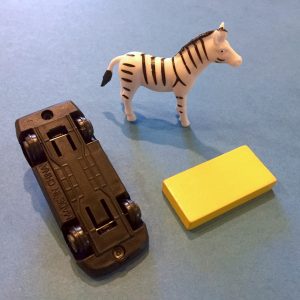
PORTL is a tabletop game that provides an interactive environment for learning about behavior principles and investigating behavioral phenomena. It is played using a collection of small objects, a clicker to select behavior, and small blocks as reinforcers.
PORTL had its beginnings in another game, called GENABACAB, which was developed by English dog trainer Kay Laurence. About a decade ago, Laurence taught this game to Dr. Jesús Rosales-Ruiz and his graduate students. The students started playing the game with each other and were hooked. They also began modifying the game to create an apparatus that could be used for teaching and research.
Students need minimal instructions initially to start playing PORTL. However, as they gain more experience with the game, they can use it to ask and answer complex questions about behavior. This gives them a sense of discovery and gets them excited to learn more about how behavior works.
Over the past decade, we have developed a series of PORTL lessons that can be used to teach basic behavior principles to undergraduate students, graduate students, and professionals. In 2019 we wrote a PORTL manual, which is available in our online store.
Watch this video to see PORTL in action
PORTL can be used for:
Teaching: PORTL allows students to see the principles of behavior in action and practice applying these principles to change behavior. It is essentially a portable Skinner box for humans. PORTL also builds empathy and understanding. While playing the role of the learner, students experience what their clients might be feeling.
Inquiry: Often, students have questions about how particular behavioral phenomena work, but do not have easy access to experimental equipment for asking these questions. PORTL can be used to model different behavioral phenomenon and ask questions about controlling variables. These types of exploratory projects help students improve their analytic skills.
Research: PORTL offers a convenient and low-cost apparatus for conducting research studies. In addition, the time required for each participant to complete a study is short, usually under an hour. This is an advantage both for recruiting participants and for teaching students how to design, implement, and refine experimental procedures.
For more information about PORTL, please see the article “The PORTL Laboratory” by Mary E. Hunter and Jesús Rosales-Ruiz, which was published in 2023 in the journal Perspectives on Behavior Science. Here is a link where you can read the article for free.
Visit the Resource Section of our website for more PORTL videos.
Further reading
- In 2019, Dr. Jesús Rosales-Ruiz and Mary Hunter published the PORTL manual. The 40+ exercises in the manual will show you how to use PORTL for teaching, inquiry, and research. Visit our store to purchase a copy.
- In 2016, Operants, the quarterly magazine produced by the B. F. Skinner Foundation, published an article by Dr. Jesús Rosales-Ruiz and Mary Hunter called “PORTL: Your portable Skinner box.” Click on this link to download a copy of the magazine.
- Several master’s thesis studies at the University of North Texas have been conducted using PORTL. In May 2019, the first PORTL research study, The Power of One Reinforcer, was published in the Journal of the Experimental Analysis of Behavior.
- Dr. Traci Cihon and her master’s students have used PORTL activities for the past several years to illustrate basic behavioral concepts to undergraduate students. Rob Goodhue, Szu Chi Liu, and Dr. Cihon recently published an article in the Journal of Behavioral Education that details how PORTL can be used in undergraduate classes.
I can see this as being a very effective teaching tool. Thanks for making it available.
We do shaping with our dogs for agility, tricks and obedience behaviors. It is fascinating to see the differences in the way humans react to the games. I was wondering if the learner would have caught on quicker to the first behavior of flipping the item over and putting it in the cup if the teacher had back-chained the behaviors… i.e. teaching the “putting it in the cup” behavior first.
Hi Lynne,
Thanks for stopping by!
Backchaining would definitely be an interesting way to teach this behavior. If you have a chance, try teaching it this way to a learner. I would be curious to hear what happens.
One exercise that we sometimes suggest to our students is to take a behavior, make a plan, and teach the behavior to a couple of learners. Next, using the same behavior, think of a completely different way to teach the behavior, and go try to teach it this way to a couple more people. The students learn a lot by exploring different ways to teach the same behavior.
~Mary